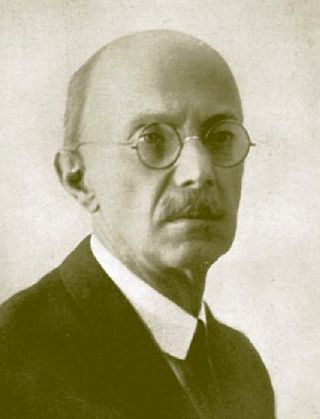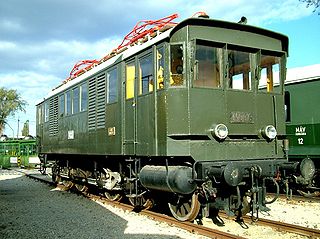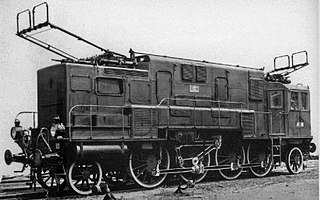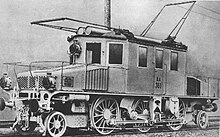
An electric locomotive is a locomotive powered by electricity from overhead lines, a third rail or on-board energy storage such as a battery or a supercapacitor. Locomotives with on-board fuelled prime movers, such as diesel engines or gas turbines, are classed as diesel-electric or gas turbine-electric and not as electric locomotives, because the electric generator/motor combination serves only as a power transmission system.

Kálmán Kandó de Egerfarmos et Sztregova was a Hungarian engineer, the inventor of phase converter and a pioneer in the development of AC electric railway traction.

The Ganz Machinery Works Holding is a Hungarian holding company. Its products are related to rail transport, power generation, and water supply, among other industries.

Hungarian State Railways is the Hungarian national railway company, with divisions "MÁV START Zrt.", and "Utasellátó". The head office is in Budapest.

Colico is a town and comune in the province of Lecco, in Lombardy in northern Italy. It is situated on the northern arm of Lake Como, where the river Adda enters the lake. Colico is the largest town in the northern part of Lake Como, which is often identified as its Colico branch.

The FS Class E.550 was a class of three-phase electric locomotive used in Italy, introduced in the 20th century, which remained in service until 1965.

Three-phase AC railway electrification was used in Italy, Switzerland and the United States in the early twentieth century. Italy was the major user, from 1901 until 1976, although lines through two tunnels also used the system; the Simplon Tunnel between Switzerland and Italy from 1906 to 1930, and the Cascade Tunnel of the Great Northern Railway in the United States from 1909 to 1939. The first standard gauge line was in Switzerland, from Burgdorf to Thun, from 1899 to 1933.

Tirano railway station (RFI) is one of two railway stations within the town and comune of Tirano, in the region of Lombardy, northern Italy. Opened in 1902, it is the terminus of the Tirano–Lecco railway.

Lecco railway station is the main station serving the town and comune of Lecco, in the region of Lombardy, northern Italy. Opened in 1863, it is the terminus of five lines, namely to Bergamo, to Como, to Milan, to Molteno and Monza and to Tirano.

Sondrio railway station serves the town and comune of Sondrio, in the region of Lombardy, northern Italy. Opened in 1885, it is located on the Tirano–Lecco railway.

The Tirano–Lecco railway is an electrified railway line in Lombardy, Italy.

Colico railway station is a railway station in Italy. Located on the Tirano–Lecco railway and the Colico-Chiavenna railway, it serves the town of Colico.

The ALe 582 is an Italian electric multiple unit train designed for commuter and medium-distance services, developed in the mid-1980s to replace pre-war and immediately post-war EMUs and locomotive-hauled trains on various lines in Sicily and Southern Italy, although they later diffused on the whole FS network. They're part of the "ALe Elettroniche" or "G.A.I." family, together with their predecessors ALe 724 and their successors, the ALe 642.

The MÁV Class V40 was an electric locomotive of the Hungarian State Railways (MÁV) and the first production electric locomotive using the Kandó system. It had a wheel arrangement of 1'D1' or 2-8-2 and a single Metropolitan-Vickers traction motor driving through side rods.

The FS Class E.360 were electric locomotives of the Italian State Railways (FS), using three-phase alternating current, built for the operation of the Valtellina line. They were ordered by Rete Adriatica and were originally numbered RA 361–363. Italian railways were nationalized in 1905 and they then became FS E.361-363 They were leased to Swiss Federal Railways (SBB) in 1906 and returned to Italy in 1907.

The FS Class E.471 locomotives were prototype three-phase AC electric locomotives designed for the Italian State Railways (FS). They constituted the first Italian experiment in using a phase converter. The final goal was to power them with single-phase alternating current, constituting the first case of a European locomotive of this type designed according to modern criteria. However, the difficulty of the development, and political interference, led to the abandonment of the project.

The Ferrovia Alta Valtellina (FAV) is a railway line in Italy which connects Sondrio, in Valtellina, to Tirano in Alta Valtellina. The railway company was established in 1899 and the line opened in 1902. Many railways in Italy were nationalized in 1905 but the Ferrovia Alta Valtellina escaped and was not nationalized until 1970.

The FS Class E.430 locomotives, initially classed as RA 34, were three-phase alternating current electric locomotives of the Italian railways. They were built for Ferrovia della Valtellina by Ganz and MÁVAG in 1901 and had a power output of 440 kW and a haulage capacity of 300 tons. One locomotive is preserved.

FS Class E.333 was a class of electric locomotives of the Ferrovie dello Stato (FS), powered by three-phase alternating current, which were in service from 1923 to 1968. They were designed by Kálmán Kandó for hauling fast passenger trains. Having the same electrical equipment as the FS Class E.552 locomotives, they presented the same defects and had to be modified. After modification, they were able to carry out the services for which they were designed.

FAV Class E.440 was a class of four electric locomotives built for the Italian Ferrovia Alta Valtellina (FAV) in 1932 for the operation between Sondrio and Tirano.





















